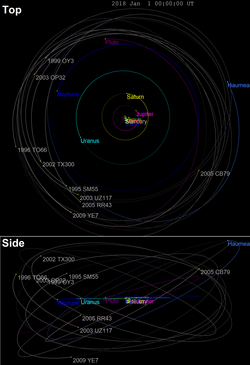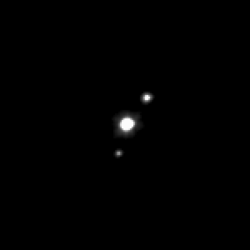 Hubble Space Telescope image of 2003 UZ117 taken in 2010 | |
| Discovery [1] [2] | |
|---|---|
| Discovered by | Spacewatch |
| Discovery site | Kitt Peak National Obs. |
| Discovery date | 24 October 2003 |
| Designations | |
| (416400) 2003 UZ117 | |
| 2003 UZ117 | |
| TNO [1] [2] · cubewano(?) [3] distant [4] · Haumea [5] Extended [6] | |
| Orbital characteristics [1] | |
| Epoch 4 September 2017 (JD 2458000.5) | |
| Uncertainty parameter 3 | |
| Observation arc | 13.23 yr (4,831 days) |
| Aphelion | 49.777 AU |
| Perihelion | 38.325 AU |
| 44.051 AU | |
| Eccentricity | 0.1300 |
| 292.38 yr (106,791 days) | |
| 339.93° | |
| 0° 0m 12.24s / day | |
| Inclination | 27.473° |
| 204.72° | |
| ≈ 20 November 2032 [7] ±2 days | |
| 247.45° | |
| Physical characteristics | |
| 222+57 −42 km [8] | |
| 6 h (poor) [9] 10.61±0.02 h [10] | |
| 0.29+0.16 −0.11 [8] | |
| BB [11] · C [12] | |
| 4.92±0.01(R) [13] ·4.920±0.083(R) [14] ·5.18±0.03 [11] ·5.22 [15] ·5.27 [12] ·5.27±0.02 [16] ·5.3 [1] ·5.4 [17] | |
(416400) 2003 UZ117 (provisional designation 2003 UZ117) is a trans-Neptunian object and member of the Haumea family, located in the Kuiper belt in the outermost region of the Solar System. It was discovered on 24 October 2003, by astronomers of the Spacewatch survey project at Kitt Peak Observatory, Arizona. [4] The object may also be a non-resonant cubewano. [3]

